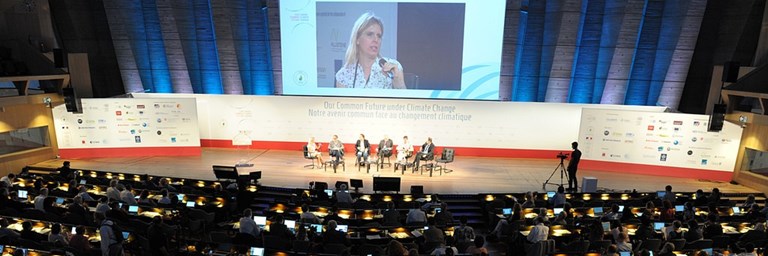To limit warming to 2°C, emissions must be zero or even negative by the end of the 21st century.
Paris, July 10 2015- The scientific conference “Our Common Future under Climate Change” (CFCC15*) covers the full landscape of scientific knowledge on climate change. The largest international science conference before the Paris COP21, with close to 2,000 participants from almost 100 countries, CFCC15 explores current understanding of all dimensions of the climate change challenge plus the full range of mitigation and adaptation options that can lead to sustainable, equitable solutions across all nations and regions.
Smart policies to manage and reduce the risks of climate change must be fair, the window for economically feasible solutions with a reasonable prospect of holding warming to 2°C or less is rapidly closing. Bold action in 2015 can be decisive in assuring a common future of sustainable, robust economies, equitable societies, and vibrant communities. To know:
1.Delaying deep emissions cuts, waiting on the sidelines by some countries, or excluding particular clean-energy technologies all increase costs and complexity. Cost-effective mitigation pathways to limit warming to 2°C require reducing emissions of greenhouse gases by 40–70% below current levels by 2050.
2. Mitigation over the next few decades will be pivotal in determining the amount of longterm warming and associated risks. But even with ambitious mitigation, much of the climate change over the next few decades is unavoidable as a result of both climate processes and the natural lifecycle of existing technology and infrastructure. Adaptation in the near term and long term can help address risks of impacts that cannot be avoided, but there are limits to adaptation.
3. Investments in climate-change adaptation and mitigation can provide a wide range of cobenefits that enhance protection from current climate variability, decrease damages from air and water pollution, and advance sustainable development. Smart responses to climate change, designed to maximize co-benefits and minimize adverse side-effects, can be part of an integrated strategy of inclusive and sustainable development.
4. Ambitious mitigation will require a range of actions, including investing in research, development, and technology transfer; phasing out subsidies on fossil energy; and pricing carbon. Pricing carbon helps level the playing field among energy technologies by charging for the damage caused by climate change and rewarding other benefits of mitigation activities.
5. Over the rest of the century, global investments in energy and energy infrastructure will total many trillions of dollars. The additional investment required to transition to clean energy can be a small fraction of this amount. With effective implementation, this additional cost can be an important contributor to inclusive and sustainable economic growth.
6. Emissions of heat-trapping gases are simpler to reduce in some sectors than in others. Decreased deforestation, energy efficiency, electricity generation, buildings, and cars are at the simpler end of the spectrum. Aviation, heavy trucks, ocean ships, and agriculture are more complicated. Technologies with huge potential include demand management, energy efficiency, solar, wind, bioenergy, and nuclear, with the possibility of breakthroughs. Improved stewardship of the Earth presents large opportunities not only for climate but also for biodiversity and ecosystem services.
